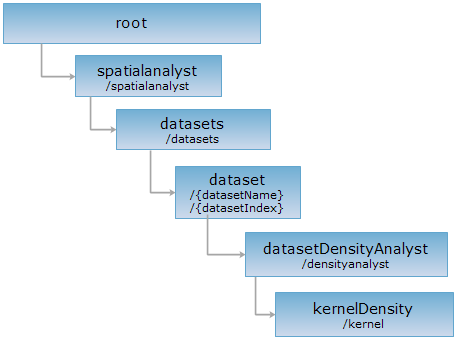
<datasetDensityAnalyst_uri>/kernel[.<format>]
The kernel density analysis result resource. Sending a POST request for this resource can create a result resource of kernel density.
Kernel density analysis, namely, use the kernel function to calculate the every unit area value in point or line scope of neighborhood. The result is smooth surface with big median and small surrounding. It reduced to zero at the neighborhood boundaries.
For the point object, the space volume combined by kernel surface and bottom plane is similar with the product of line measurement and line length. The neighborhood overlay of point or line has the same density. Every density of output is the sum of curved surface value overlayed in raster.
Supported Methods:
Supported output formats: rjson, json, html, xml.

Implement the HTTP request on the following URI, where supermapiserver is the server name, with rjson being the output format.
http://supermapiserver:8090/iserver/services/spatialanalyst-sample/restjsr/spatialanalyst/datasets/SamplesP@Interpolation/densityanalyst/kernel.rjson
Gets a form for the POST request.
Execute a kernel density analysis. Namely, create a kernel density analysis result resource.
Parameters passed in the request body are as follows:
| Name | Type | Description |
| bounds | Rectangle2D | Density analysis area, used to confirm the results of raster dataset extent. Default as the current dataset extent. |
| resultGridDatasetResolution | double | Density analysis result resolution of raster data, unit as same as current dataset. default value as current dataset's minimum value of length and width divide 500. |
| searchRadius | double | Raster neighbor range used to calculate density search radius, unit as current dataset. default value as current dataset's minimum value of length and width divide 30. |
| fieldName | String | [Required] Name field used to process density analysis measure value. Density analysis do not support text type field. |
| targetDatasource | String | Set datasource of stored results dataset, default as datasource of current analysis dataset . |
| resultGridName | String | The specified result dataset. |
| deleteExistResultDataset | boolean | Whether to overlay the existing dataset with the same name. |
Normal response code(s): 201. The response parameters are as follows:
| Field | Type | Description |
| succeed | Boolean | Whether the analysis is successful. |
| newResourceID | String | The ID for the analysis result resource. |
| postResultType | PostResultType | The result type of the POST request. |
| newResourceLocation | String | The URI of the newly created resource. |
Implement the POST request on the kernelDensity resource http://localhost:8090/iserver/services/spatialanalyst-sample/restjsr/spatialanalyst/datasets/SamplesP@Interpolation/densityanalyst/kernel.rjson. The returned rjson is as follows:
{
"resultGridDatasetResolution": 3000,
"searchRadius": 2000,
"fieldName": "AVG_TMP",
"targetDatasource": "Interpolation",
"resultGridName": "test",
"deleteExistResultDataset": true
}
The response result in rjson format returned is as follows:
{
"succeed": true,
"newResourceID": "6b7fe42a934c49fa93fe5b8b7541d2db_568ab41863944b739a73aae99fac5bfd",
"postResultType": "CreateChild",
"newResourceLocation": "http://localhost:8090/iserver/services/spatialanalyst-sample/restjsr/spatialanalyst/datasets/SamplesP@Interpolation/densityanalyst/kernel/6b7fe42a934c49fa93fe5b8b7541d2db_568ab41863944b739a73aae99fac5bfd"
}
The returned child resource is http://localhost:8090/iserver/services/spatialanalyst-sample/restjsr/spatialanalyst/datasets/SamplesP@Interpolation/densityanalyst/kernel/6b7fe42a934c49fa93fe5b8b7541d2db_568ab41863944b739a73aae99fac5bfd, which contains the result dataset of kernel density analysis.
Asks for the response identical to the one that would correspond to a GET request, but without the response body. This is useful for retrieving meta-information written in response headers, without having to transport the entire content. The meta-information includes the media-type, content-encoding, transfer-encoding, content-length, etc.
HEAD request can be used to check if the kernelDensity resource exists, or if the kernelDensity resource can be accessed by clients. It can also determine if the kernelDensity resource supports an output format <format> if performed on a URI with .<format> included.